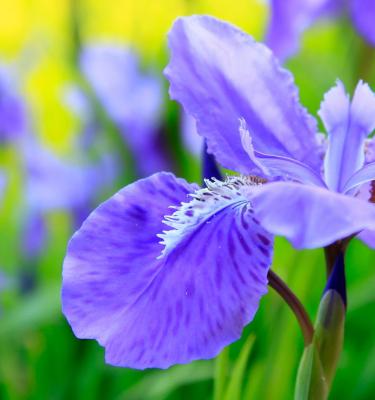

The Ultimate Guide to Growing Iris Flowers
Iris flowers appear in spring and summer in Australia on long, slender stems that can be around 60-100cm tall. Irises make wonderful cut flowers and look beautiful when mass planted in gardens or clustered together in decorative pots. Iris can be grown in cool to subtropical climates depending on the species or variety - look for one that suits your climate best.
There are a number of Iris species available to the home gardener including;
Bearded Iris - Iris germanica
Dutch Iris - Iris reticulata
Siberian Iris - Iris siberica
Japanese Iris - Iris ensata & Iris kaempferi
Iris grow from rhizomes that prefer growing close to the soil surface. Over time the rhizome of a single plant will grow and spread. These rhizomes can be dug and divided when the plants are dormant, allowing you to grow your iris plant population!
Irises generally flower in spring and summer, although there are some forms that produce blooms in winter. The foliage of iris plants is elongated and sword-like - it can be dark green, green or a blue/grey colour depending on the species.
5 top tips for growing iris
- Choose a full sun position for your iris to grow in
- Iris need a rich, free draining soil so the rhizomes don’t rot. If your soil is heavy, choose to grow iris in pots instead
- Iris make great cut flowers, regularly picking the blooms will encourage more to follow.
- Fertilise iris with a fertiliser designed for flowering plants during the growing season to encourage lots of blooms. Look out for Scotts Osmocote Pour+Feed for Flowering Plants.
- Watch out for slugs and snails attacking the young shoots of iris plants - sprinkle around Defender Slug and Snail Pellets to control them if needed.
Essential shopping list for growing iris flowers
- Dormant iris rhizomes or potted iris planted
- Scotts Osmocote Compost Premium Soil Improver
- Scotts Osmocote Pour+Feed for Flowering Plants
- If growing in pots, Scotts Osmocote Premium Potting Mix
- Garden trowel
- Secateurs
- Defender Pyrethrum Insect Spray
- Defender Slug and Snail Pellets
Prepare
You’ll find dormant iris rhizomes for sale from late summer to early autumn at your local nursery or garden centre - this is also the best time to plant them out.
Irises prefer a full sun in a free draining, compost rich soil. Prepare the soil for planting by digging Scotts Osmocote Compost Premium Soil Improver through the top 20cm of soil before planting.
If your soil is heavy or not free draining consider growing iris in pots instead.
Growing irises in the garden
Plant iris rhizomes into prepared soil 20-40cm apart - depending on the variety, always follow the labels instructions. Iris rhizomes should be planted at soil level or slightly below with the root side of the rhizome facing down and the stem side facing up. Don’t completely cover the top of the rhizome with soil or mulch as it may rot. Water in well and fertilise your iris once shoots emerge.
Growing irises in pots
You can grow iris in pots - choose a pot that has plenty of drainage holes and a compact or dwarf growing iris.
Fill your pot with a premium, free-draining potting mix like Scotts Osmocote Premium Potting Mix before planting your iris rhizomes into it. Remember to keep the top of the rhizome at or slightly above the level of the potting mix with the root side of the rhizome pointing down. Water in the rhizomes and fertilise them once shoots emerge.
Fertilising iris flowers
Fertilise your iris fortnightly in spring with a liquid fertiliser like Scotts Osmocote Pour+Feed for Flowering Plants. Continue to fertilise as the plant dies back at the end of summer to help it store energy for the coming flower season.
Harvesting iris flowers
Use sharp scissors or secateurs to harvest iris flowers to make floral arrangements. Cut down low on each flower stem, close to the plant - this will encourage further blooms.
Remove any dead flowers to stop your iris plants putting energy into producing seed heads.
Once the flowers have completely stopped and the foliage has begun to die back, you can either lift the rhizomes and replant them somewhere else or leave them in the ground to flower the following season.
Common iris pests and diseases
The new shoots of iris are susceptible to slug and snail attack. Use beer traps (saucers filled with beer placed on the soil surface) or sprinkle around Defender Slug and Snail pellets to control these pests.
Reduce the risk of a powdery mildew outbreak on your iris leaves by avoiding overhead watering when you can. If you spot any powdery mildew or fungal infected leaves, remove and dispose of them immediately.
Control aphids on irises by either hosing them off with a strong squirt from your hose or using an insecticide like Defender Pyrethrum Insect Spray.



